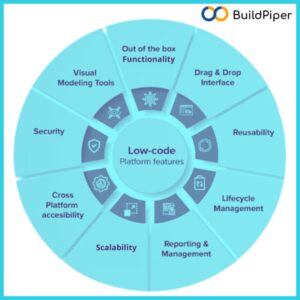
Low-code is an app development process that focuses on visual development and interfaces to enable quick app delivery with minimal hand-coding. Know more about low-code development, its benefits and much more here, in this article!
What is Low-Code Development?
Low-code development is a visual approach to software development that empowers product teams and developers to build apps with minimal hand-coding. The graphical user interface and the drag-and-drop features of low-code no-code platforms automate aspects of the overall development process. Low-code platforms enable the faster building of codes and eliminate dependencies on traditional computer programming approaches.
These platforms help product teams in creating apps with next to no coding and empower enterprises with a rapid software setup and deployment. With these characteristics and attributes, low-code applications and platforms,
- Abstract away lengthy and time-consuming codes behind complex commands and actions.
- Enable the completion of projects within the shortest span of time.
- Empower businesses with faster app delivery.
A report by Gartner forecasts that by 2024, the low-code development practice will be widely adopted. Approximately 75% of the software solutions built around the world will be made with the help of such tools.
While these tools won’t completely replace traditional software development, they’re a modern approach to simpler and faster app building.
Benefits of Low-Code Development
Whether it is automating individual manual tasks, eliminating traditional development models or making it easier for a tech startup or an established enterprise in building a prototype or a flexible app, low-code development has many benefits. Major benefits of low-code software include,
Helpful for Non-technical Audiences
In a hyper-personalized world, creating distinct solutions at a rapid pace that too behaving similarly across multi-channel platforms, is a game-changer. Low-code applications and platforms expedite digital programs by enabling a wider, non-technical audience to cater to problems and come up with perfect solutions rapidly.
For professionals who are not well-versed in technology, low-code platforms are of great help. They can work with these platforms without the need for an in-depth knowledge of the core technologies.
A report by Gartner report said that 80% of technology products and services will be created by people outside of tech-driven fields by 2024.
And in times when the demand for commercial software, new progressive solutions and skilled developers exceeds the supply, low-code tools are a perfect fit for designers, professional developers, non-technical stakeholders and others.
Faster Development Cycles
Low-code app development increases the pace of development cycles. People with no coding background and experience can now create digital products. As there is no dependency on techies and experts, teams with nominal knowledge can also involve in the actual development thus speeding up the entire process. Impeccably functioning products and visually appealing designs can be concocted in a matter of minutes instead of weeks. That’s really awesome, isn’t it?
Increased Productivity across Teams
Low-code development bridges the gap between IT and business teams so that both can solve real and critical issues impacting the company’s growth. Business teams can create their own applications, without waiting for developers to hop in. This way development teams can focus more on solving complex code issues which enhances productivity. New ideas can be launched more quickly as developers can invest more time in building logical solutions rather than solving redundant issues.
Improved Velocity and Optimized Development Cost
Speed is the need of enterprises for surviving in today’s competitive market space. Global customers and clients want their software to be built within brief timeframes and within a strict budget. Legacy systems within enterprises require rapid modernization without the need for a big investment. One of the greatest benefits of low-code no-code platforms & tools is that they let enterprises build at scale without incurring heavy costs or consuming too much time. Automation apps, mission-critical systems and highly-intriguing mobile applications can all be developed with low-code software.
Rapid Prototyping
One of the greatest benefits of low-code app development is that it enables non-coders to prototype solutions quickly. These solutions can later be tested, evaluated and refined without having to involve the software development teams. Proposed solutions can be compared, discarded or reformed to the point where they’re considered mature enough to be passed on to development for a more optimal implementation. This helps in increasing the productivity of the development team as they can focus on core technical aspects rather than investing time in solving issues related to prototypes.
Use of Low-Code Platforms in DevOps
In the DevOps industry, the use of low-code platforms is on the rise. Businesses and teams choose to go for low-code no-code platforms to reduce costs and improve developer productivity. Besides, low-code platforms, the use of Kubernetes & Microservices management platforms such as BuildPiper can help enterprises with reduced cost, faster time to market and rapid microservices delivery.
BuildPiper is one such platform that enables teams to manage onboarding, management, logging, monitoring and deployment through a single console. DevOps teams can manage Microservices applications with ready-to-use built-in templates.
BuildPiper is a one-stop solution for managing the entire lifecycle of a containerized application. Right from environment setup to build and deployment- everything is available as a plug-and-play solution and is fully customizable.
To explore other interesting features of this platform, schedule a Demo NOW!




